Katana Tsuka Introduction of the handle of Samurai Sword
Complete guide to understand the Katana Handle "Tsuka 柄"

The Katana is a traditional Japanese sword famous for its sharpness and elegance. The Katana handle is crucial to the construction of the sword. If you happen to be a swordsman in training or a Katana enthusiast and want to know about this essential part of the Japanese sword, then you’ve come to the right place!
Table of Content
- What is Tsuka 柄?
- Material of Katana Handle
- Katana Handle Parts
- Katana Handle Shape 柄形
- Katana Handle History
- Katana Handle Types
- Katana handle wrapping styles
- How to made katana handle
- The Importance of a tight and secure tsuka for a Katana
What is Tsuka 柄?
The Tsuka “柄“ is the handle of the Katana. Designed to fit snugly in the hand, the tsuka's shape and size are tailored to enhance balance, control, and comfort during use, allow the users to make precise and powerful strikes. Tsuka is an essential part of a Katana sword, Tsuka can bring out the full potential of the Japanese sword as a weapon.
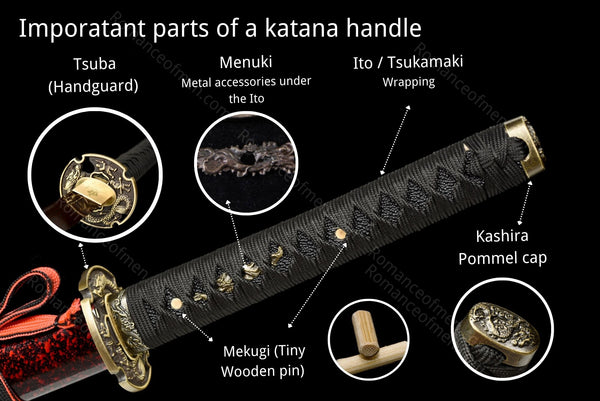
The handle materials typically include wood wrapped in ray skin (Samegawa) and silk or cotton cord (Ito). The wrapping provides a secure grip for the user and adds to the sword's aesthetic appeal. The Tsuka is secured to a Katana's tang (Nakago) with two bamboo pins (Mekugi) and a metal ferrule (Habaki).
How long is a Katana handle?
The length for katana handle is usually 10-12 inches (25-30 cm). That's because the katana is a two-handed sword, with the blade often exceeding 60 cm, requires a handle long enough for both hands. This makes the handle about 30% of the katana's total length, ensuring balance for improved control and precision.
The ideal Katana Handle Size
The length of a katana handle was traditionally customized to suit the individual swordsman's needs, ensuring optimal grip and maneuverability. A general guideline for determining the appropriate handle length is to measure twice the width of the user's hand plus an additional two fingers' width for a katana. For a wakizashi, the shorter companion sword, the handle length is about 1.5 times the hand width, while for a tanto, the small knife or dagger, it matches the width of one hand.
Material of Katana Handle
The katana handle is crafted from several key materials, each contributing to the sword's functionality or aesthetics:
Wood for the Body (柄下地, Tsuka-shitaji): The core of the handle is made from a single piece of wood, meticulously carved to snugly fit the sword's tang. This wooden core forms the structural backbone of the handle, ensuring the blade is securely held.
In ancient Japan, the main materials for Tsuka-shitaji were purple sandalwood 紫檀, agarwood 沈香, and rhinoceros horn 犀角. But in modern days, magnolia wood 朴木, known for being hard and water-resistant, has become the most popular choice. Magnolia wood is soft to the touch and has excellent water absorption properties, making it popular not only for handles but also for sheaths (Saya).

Ray Skin (鮫皮, Samegawa): The wooden core is wrapped in ray skin, known as samegawa, valued for its robust texture and resilience. Samegawa reinforces the handle's structure and provides a distinct, non-slip surface, enhancing the wielder's grip.
Finding the ideal types of ray fish for samegawa (ray skin) in Japanese waters is challenging, leading to the majority being imported. This scarcity and the need for importation contribute to their high cost.
The value of samegawa (ray skin) is usually determined by its grains, the larger and more uniform grains means higher value , especially those with prominent bumps known as "oya-tsubu 親粒". These large bumps, which can number three or four in a row at the center of the skin, are particularly prized. These grains are intentionally made visible through the gaps of ito wrapping to highlight the exquisite craftsmanship and quality of the material.

Image source : Bigport Leather
Cords for Ito Wrapping (糸巻き, Ito-maki): Silk or cotton cords are tightly wound over the ray skin in a decorative and functional pattern, known as ito wrapping. This wrapping secures the underlying layers together, offering additional grip and aesthetic appeal. The choice of wrapping style can reflect the artisan's signature technique or the bearer's personal taste.

Image source : murayamatouken.com 株式会社村山刀剣
Metal Parts (Menuki (目貫), Fuchi (縁), Kashira (頭)): The handle is adorned with metal fittings that serve both ornamental and structural roles. Menuki are decorative elements placed beneath the ito wrapping to improve grip and balance. Fuchi and kashira are metal collars and caps at the handle's ends, providing reinforcement and contributing to the katana's visual elegance. These components are often intricately crafted, displaying the metalworker's skill and embodying symbolic or aesthetic significance.

Image source : tokka.biz
Katana Handle Parts
A Brief Introduction To All Components Of A Katana Handle (Tsuka)

The Tsuka is an intricate piece that consists of many components, we will introduce each one here to help you better understand the Katana handle:
1. Fuchi (縁)
The Katana's Fuchi is the metal ring of the handle that supports the blade's structure and conceals the handle. It typically contains carvings of traditional patterns, like dragonflies. This part is also called "Kabutogane (冑金)" in Tachi Koshirae.
2. Tsuka-Ito (柄糸)
The "rope" that fully wraps the handle is called the Tsuka-Ito. This section of the Katana requires a unique set of skills and resources. You may find Itos manufactured from various materials, cotton and silk are most common, other material including polyester, leather, suede etc.
3. Samegawa (鮫皮)
The material that wraps around the hilt of a sword is Samegawa. The typical materials for this part are Stingray skin. This material provides an excellent grip for the Ito and is ideal for absorbing impacts and looking good while doing so.
4. Mekugi (目釘)
A Mekugi is a wooden peg. These Mekugi run through the tang and secure the handle to a blade. Even without them, the handle is rather sturdy. But for safety, there must be at least one Mekugi for a Katana.
5. Menuki (目貫)
The term "menuki" refers to the small metal ornaments on a Katana handle . This part's materials typically come from various metals, such as copper and brass. They are customary adornments on the Katana's handle and improve the grip.
6. Kashira (頭)
The Katana's pommel is called Kashira. The Fuchi and the Kashira are parts that often share similar designs. This part serves as a place to fasten the Tsuka and the other parts of the handle. It also provides a striking aesthetic contrast. This part is also called "Fuchikanamono (縁金物)" in Tachi Koshirae.
Katana Handle Shape 柄形
The term "tsukagata" 柄形 refers to the shape of the katana handle, depends on different era, or usage, the most popular types of katana handle shapes are:
Tachi Tsuka 太刀柄 (Means handle for tachi, some might call it Morozori):

Tachi 太刀 was designed to be used on horseback, so the handles are curved to make them easy to hold with one hand. This type of handle is longer and curves smoothly from the blade to the end, making it easy to draw quickly in battles on horseback.
There were also tachi handles covered with rough ray skin only and no ito wrap. Rough ray skin are not comfortable to grip, so most of these Tachi were for ceremony, or collection, not for actual battles. However these was another theory, because archers at that time were mainly samurai wore full set of Japanese armor, and they have leather glove called "yugake 鞢," so holding the rough handle will not hurt them and make this type of handle useable in battlefield.
Narabi-sori 標準 / 並反 (Means Standard Tsuka, some might call it Haichi):
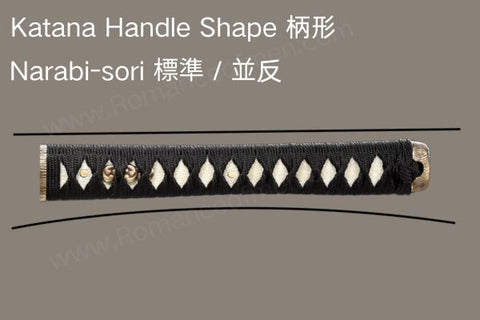
This shape gently curves only on the back edge (mune, 棟) of the handle. It means the part of the handle closest to the back of the sword bends slightly, giving it a subtle curve.
Imogata 芋形 (Means Taro Shape):
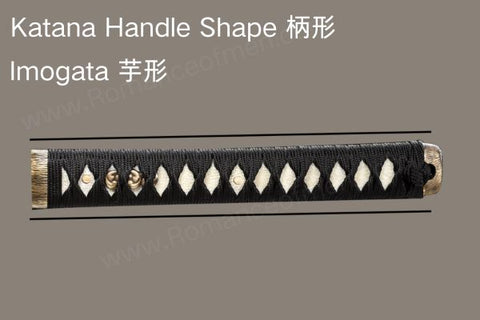
Neither the blade side (ha, 刃方) nor the back side (mune, 棟方) of the handle is curved. This shape is straight and does not have any bends, resembling the simplicity of a taro (because in Japanese cuisine, taro often cut into hexagon shape) , hence the name.
Ryotatsu-tsuko 両立鼓 (Means Both Sides Drum, some might call it Rikko or Ryugo):

Both the blade side (ha, 刃) and the back side (mune, 棟) of the handle are curved. This means the handle bends on both sides, creating a shape that is more symmetrical and balanced, similar to a drum or hourglass viewed from the side, indicating curvature on both aspects of the handle.
The Ryotatsu-tsuko design is perfectly suited for extended periods of katana use. Katana isn't a light sword, when you practice, your forearm will be exhausted sooner than you expected. Ryotatsu-tsuko fits comfortably in the hand, allowed for secure grip and somehow make you feel the katana is "lighter", significantly improving the sword's maneuverability and strike power.
Katana Handle History
During the Heian and Kamakura periods, samurai mainly used the tachi sword while fighting on horseback. The tachi's handle and blade were curved to make it easier to slash and quickly draw the sword while riding. This design helped samurai cut down their enemies more effectively during mounted battles.
In later times, during the Nanbokucho and Muromachi periods, battles involved more fighting on foot. This shift led to the development of the uchigatana 打刀, a sword designed for use with both hands. The uchigatana had a straighter and longer handle, making it better for foot soldiers who needed to swing their swords with more power and control. The most ideal type of handle for Uchigatana is the rikko tsuka. The middle part of this handle was made a bit thinner, making the sword easier to hold and use in close fights. This change in the sword's handle shape shows how Japanese sword-making evolved to meet the needs of warriors as their way of fighting changed.
Katana Handle Types
Thread Wrapped Handle (糸巻柄, Ito Maki Tsuka) : combines various styles of thread wrapping techniques to create different textures and grips on the katana handle.
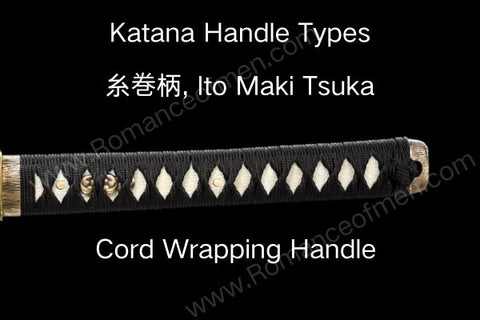
Leather Wrapped Handle (革巻柄, Kawa Maki Tsuka): Wrapped with dyed deer leather or smoked leather using straw smoke. This style was popular until the early Edo period.
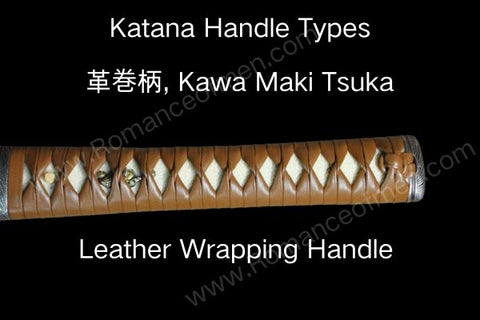
Ray Skin Handle (出鮫柄, Dashi Zame Tsuka): A handle covered only with ray skin without any wrap, commonly found on Tanto or Tachi. Primarily used for ceremonial purposes as gripping bare ray skin can be painful.
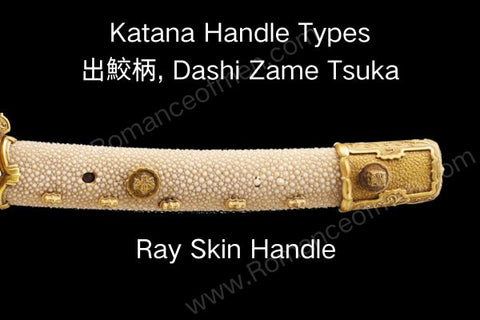
Pressed Ray Skin Handle (圧出鮫柄, Heshi Dashi Zame Tsuka): Features a metal plate with ray skin-like protrusions instead of actual ray skin, traditionally used for decorative swords. Some luxurious versions from the Azuchi-Momoyama period are adorned with gold dust.
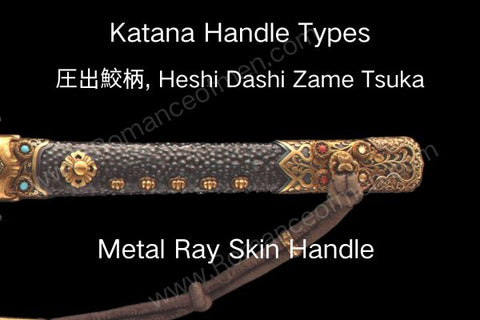
Lacquered Handle (塗柄, Nuri Tsuka): A handle without any wrap, simply coated with lacquer. Ray skin is not used in this design.
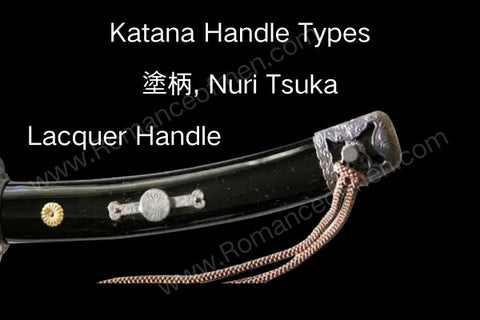
Tang Wood Handle (唐木柄, Karaki Tsuka): Made from imported exotic woods like purpleheart, without using ray skin. These woods typically came from China during Tang dynasty. that's why it's called Tang wood.
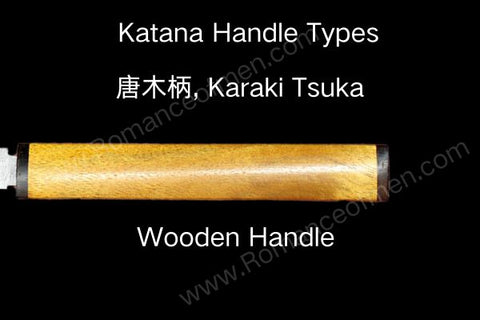
Katana handle wrapping styles
There are many types of ito wrapping for the katana handle, we will introduce the briefly the most popular and common ones, they are:
Flat Wrap (平巻, Hiramaki): Layering flat-woven cords in a crisscross pattern, resulting in a smooth, flat surface without bulges. Hiramaki is mainly on Tachi, especially the Ito-maki Tachi (糸巻太刀 ).
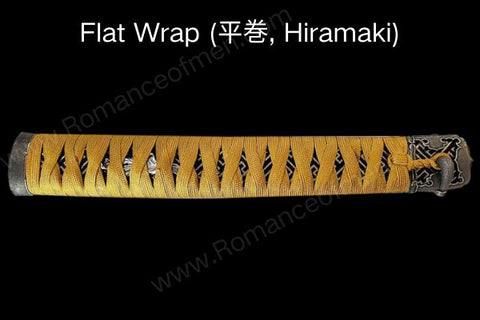
One-handed wrap (片手巻 Katate Maki) : It is a way of wrapping without crossing the cords, instead winding them in a spiral tight around the handle. It's considered the original method for all types of handle wrapping.

Twisted Wrap (諸捻巻, Morohinerimaki): Twisting both top and bottom cords before wrapping, creating a raised texture. Some said this wrapping method is least likely to come loose.
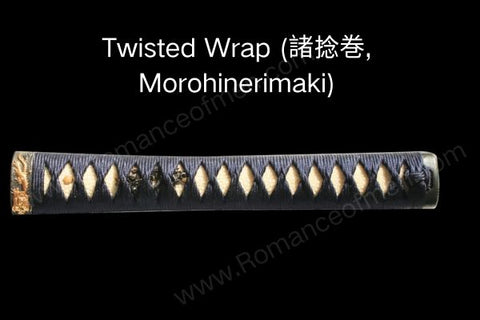
Double Pinch Wrap (諸撮巻, Morotsumamimaki): Pinching both the top and bottom cords before wrapping, leading to a significantly raised overlap. This is common for modern decorative purposes.

Stair Wrap (雁木巻, Gangimaki): Laying the cords side by side in a stair-like pattern, resembling a flock of geese flying in formation. also known as "Musashi Wrap 武蔵巻" after the famous swordsman Miyamoto Musashi who invented it.

Jabara-ito Group Upper Wrap (蛇腹糸組上巻, Jabaraito Gumiagemaki): Wrapping the cords in layers to create a pattern resembling the scales on a snake's back.
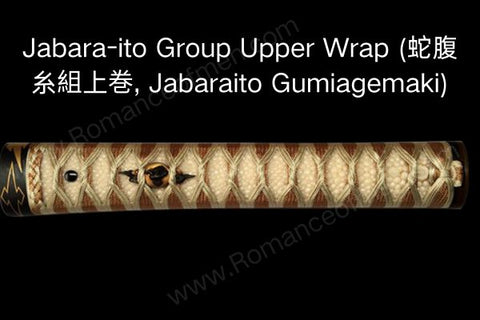
Other Katana handle wrapping styles:
Line Wrap (篠巻 Shinomaki): Wrapping three cords as a set, with only the middle cord twisted and the others folded back.
Entwined Wrap (絡巻, Karamemaki): Similar to Shinomaki but with the side cords twisted.
Knot Wrap (結巻, Musubimaki): A method where the side cords of Shinomaki are knotted.
Twisted Wrap (捩巻, Nejirimaki): Twisting the top and bottom cords twice before wrapping.
Straight Wrap (文字掛け・巻戻し, Mojikake・Makimodoshi): Wrapping flat cords directly around the handle.
Pinch and Twist Wrap (方撮巻, Katatsumamimaki): Pinching the top cord and twisting the bottom cord before wrapping.
For more info about Katana handle wrapping, we have a more detailed guide here.
How to made katana handle
In traditional katana making process, The creation of the handle typically involves the collaboration of two artisans: the Sayashi (鞘師), who crafts the wooden base of the handle (柄下地), and the Tsukamakishi (柄巻師), responsible for covering it with ray skin and completing it with the ito wrapping. The details process are:
Prepare the Handle Wood: Start by selecting a piece of magnolia wood and cutting it to the desired length of the handle. Make sure to leave some extra space for the width and length.
Trim the Ends: Trim the ends of the handle, keeping in mind the balance with the sheath.
Fit the Katana Parts: Fit the habaki (blade collar), seppa (spacers), and tsuba (guard) onto the handle.
Mark and Carve for the Tang: Place the nakago (tang) on the wood, marking its outline. Consider the sheath for balance. Carve a groove for the tang to fit in, making sure the groove's depth matches the tang's thickness.
Shape the Handle: Saw off any excess wood to shape the handle. Adjust the edges to fit the metal fittings while ensuring a balance with the sheath. Mark and saw according to your preferred handle shape.
Glue the Handle: Glue the two halves of the handle together using wood glue.
Polish the Handle: Shape and polish the handle's exterior using a plane or similar tool. Carve grooves for the ray skin wrap, leaving space for the cord wrap at certain points.
Adjust for Samegawa: If using a strip of shark skin, carve a groove to fit its width. Adjust the groove or the skin's edges to ensure a snug fit without protruding above the wood surface.
Drill the Mekugi Hole: Before gluing the handle pieces together, insert the tang to mark where the mekugi (peg) hole should be, then drill the hole. After gluing, adjust the hole if necessary.
Attach the Samegawa: Place the ray skin in the groove, using wood glue to adhere it securely.
Wrap the Handle: Finally, wrap the handle with the cord (ito) to finish your katana handle. There are many different ways to wrap the handle, but an important part of all these methods is making sure the large bumps on the shark skin, known as "oya-tsubu 親粒," are nicely visible between the diamonds of the wrap.
The Importance of a tight and secure tsuka for a Katana
A secure and tight handle (Tsuka) on a Katana is crucial for optimal performance, control, and safety. A well-fitted Tsuka ensures proper balance and grip, enhancing the wielder's accuracy. Conversely, a loose Tsuka can make the sword unstable and increase the risk of injury.
Safety hinges on the Tsuka's tightness, preventing the katana from slipping during use. A well-maintained and tightly wrapped handle contributes to a comfortable and firm grip, essential for confident and precise sword handling.
A good katana handle plays critical role in enhancing a katana's sharpness as well. Especially the Rikko style tsuka. Its design, slightly constricted in the middle like a drum, is not only traditional but optimally designed for grip and control. This shape allows for powerful one-handed cuts and improves the wielder's ability to manage the sword effectively, especially in two-handed stances. The Rikko Handle's design compensates for any potential shortcomings in the blade's sharpness, proving that a well-crafted handle is essential for a sword's effectiveness and the wielder's safety.
A loose Tsuka often signals inadequate maintenance and can pose dangers. It typically results from improper fitting or the need for maintenance of the Tsuka-Ito. Over time, the Tsuka-Ito will naturally start to loosen due to regular use. However, high-quality Tsuka-Ito tends to stay tight and secure for a much longer period.
Proper initial wrapping of the Tsuka-Ito is vital to prevent accidents during practice (Keiko). If not wrapped or maintained correctly, the Tsuka can become loose, compromising the sword's integrity. Ensuring the Tsuka-Ito is tightly secured is essential for every swordsman.





















